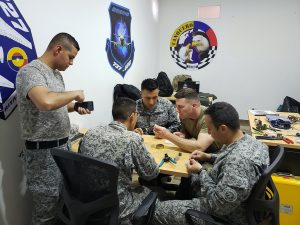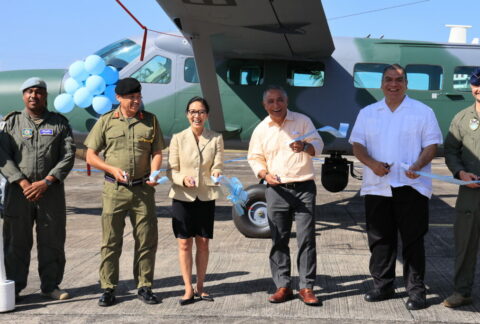U.S. Air Force airmen from the 571st Mobility Support Advisory Squadron (MSAS) worked with the Colombian Armed Forces as part of a mobile training team from February 11 through March 11 at two air bases in Colombia.
The team was comprised of 15 air advisors from the 571st MSAS at Travis Air Force Base, California, and six total force instructors from three other U.S. Air Force units. The training covered a variety of areas of cooperation between the U.S. and Colombia.
It aimed at supporting Colombia in their pursuit to counter transnational and transregional threat networks and to enhance the capability of the Colombian Air Force (FAC, in Spanish) to maintain regional security through increased proficiency in mobility support operations.
The training was conducted at the Military Air Transport Command in Bogotá, and the 1st Combat Air Command in Palanquero, both in Colombia. The training topics focused on C-130 aircraft maintenance, aerial firefighting procedures, search and rescue, intelligence, and medical intelligence.

The C-130s, located at the Military Air Transport Command, are the workhorse of the FAC fleet, capable of conducting a diverse mission set. Throughout the engagement, 571st MSAS maintenance air advisors worked with the FAC to develop their maintenance philosophy, systems knowledge, and best practices and procedures. A heavy focus was placed on the C-130 engine, hydraulic, fuel, environmental and electrical system familiarization, and troubleshooting.
Instructors conducted training through classroom briefings and hands-on training on the aircraft, to gain a thorough understanding of Colombian maintenance practices.
“The students were very engaged in the training we provided,” said U.S. Air Force Technical Sergeant Jacob Haines, 571st MSAS advisor. “I am confident that our students’ capacity to properly maintain their C-130 fleet has increased.”
Additionally, the 571st MSAS team provided ground training to the Colombian air force on Modular Airborne Fire Fighting Systems, or MAFFS, a system loaded into the back of a C-130 aircraft that drops fire retardant to aid in stopping the spread of wildfires.
Employing an aerial firefighting capability will help the FAC in combatting wildfires, both internally and internationally. The specialized training, provided by the U.S. Air Force Reserve Command personnel, was a stepping stone to future work with the FAC on further enhancing this capability.
“While a very effective fire-fighting tool, this specific mission set requires consistent practice,” said U.S. Air Force Lieutenant Colonel Richard Pantusa, 731st Airlift Squadron MAFFS instructor pilot from Peterson Air Force Base, Colorado. “It is inherently a dangerous mission — flying low over mountainous terrain that is on fire. The FAC has a new MAFFS program that includes highly motivated and knowledgeable C-130 operators who are attempting to grow their MAFFS program.”
The building partnership capacity missions the MSAS conducts, not only enhance the capabilities of the partner nation forces but also furthers the objectives of the U.S. in building strong international relationships. This mutual cooperation and support will assist both the U.S. and partner nations in crisis response operations by enabling the nations to coordinate together.









